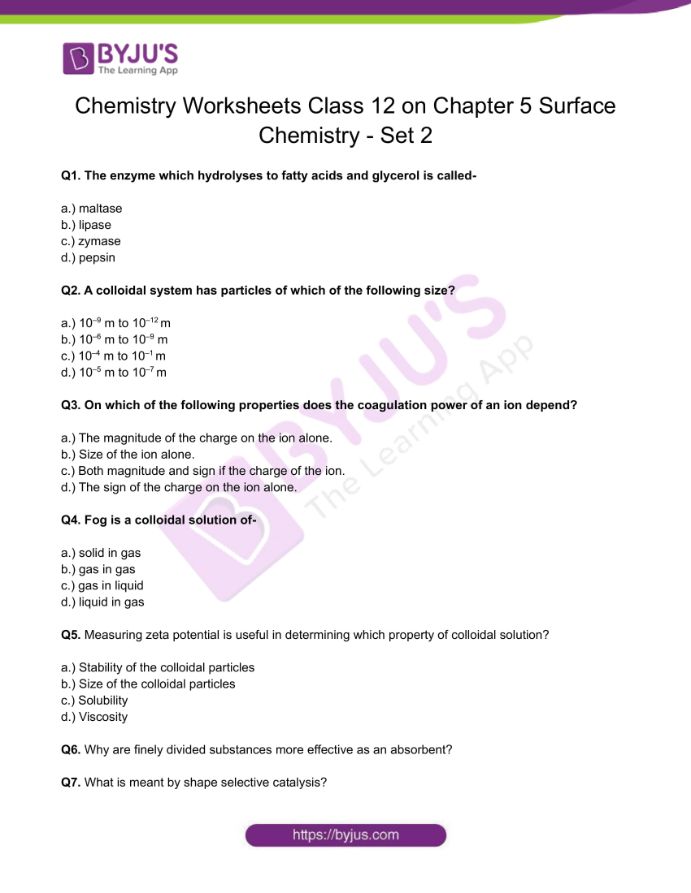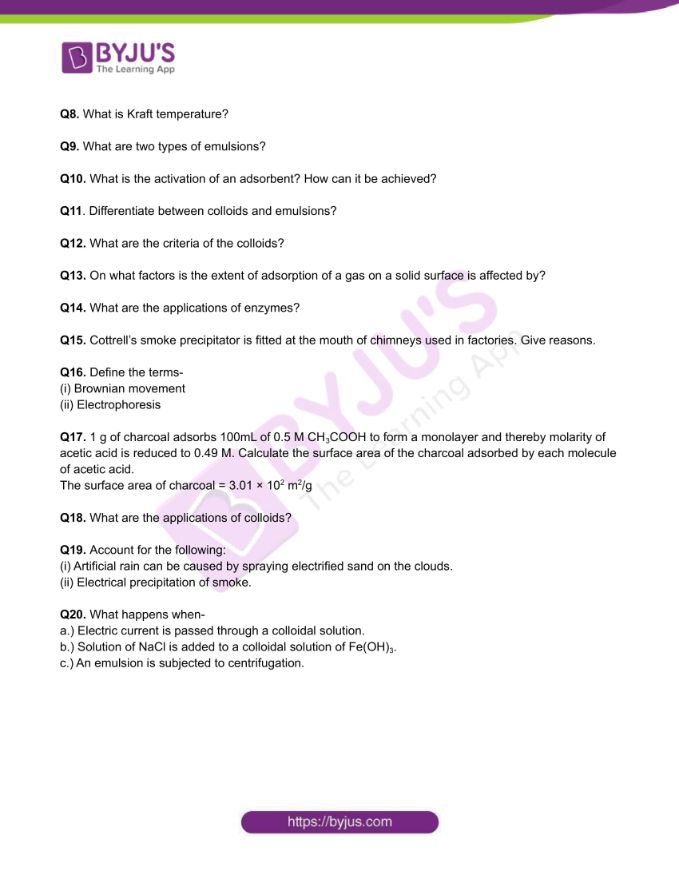Surface chemistry has numerous applications in analytical work, medicine, the paint industry, and so on. It is the investigation of chemical reactions that occur at the interface of two surfaces, which can be solid-liquid, solid-gas, solid-vacuum, liquid-gas, and so on. Surface engineering refers to some surface chemistry applications. There are a variety of phenomena that occur on the surface of substances, including –
- Adsorption
- Heterogeneous Catalysis
- Corrosion
- Crystallization
Download Class 12 Chemistry Worksheet on Chapter 5 Surface Chemistry Set 2 PDF
CBSE Class 12 Chemistry Chapter 5 Surface Chemistry Worksheet – Set 2
Q1. The enzyme which hydrolyses to fatty acids and glycerol is called-
a.) maltase
b.) lipase
c.) zymase
d.) pepsin
Q2. A colloidal system has particles of which of the following size?
a.) 10–9 m to 10–12 m
b.) 10–6 m to 10–9 m
c.) 10–4 m to 10–1 m
d.) 10–5 m to 10–7 m
Q3. On which of the following properties does the coagulation power of an ion depend?
a.) The magnitude of the charge on the ion alone.
b.) Size of the ion alone.
c.) Both magnitude and sign if the charge of the ion.
d.) The sign of the charge on the ion alone.
Q4.Fog is a colloidal solution of-
a.) solid in gas
b.) gas in gas
c.) gas in liquid
d.) liquid in gas
Q5. Measuring zeta potential is useful in determining which property of colloidal solution?
a.) Stability of the colloidal particles
b.) Size of the colloidal particles
c.) Solubility
d.) Viscosity
Q6. Why are finely divided substances more effective as an absorbent?
Q7. What is meant by shape selective catalysis?
Q8. What is Kraft temperature?
Q9. What are two types of emulsions?
Q10. What is the activation of an adsorbent? How can it be achieved?
Q11. Differentiate between colloids and emulsions?
Q12. What are the criteria of the colloids?
Q13. On what factors is the extent of adsorption of a gas on a solid surface is affected by?
Q14. What are the applications of enzymes?
Q15. Cottrell’s smoke precipitator is fitted at the mouth of chimneys used in factories. Give reasons.
Q16. Define the terms-
(i) Brownian movement
(ii) Electrophoresis
Q17. 1 g of charcoal adsorbs 100mL of 0.5 M CH3COOH to form a monolayer and thereby molarity of acetic acid is reduced to 0.49 M. Calculate the surface area of the charcoal adsorbed by each molecule of acetic acid.
The surface area of charcoal = 3.01 × 102 m2/g
Q18. What are the applications of colloids?
Q19. Account for the following:
(i) Artificial rain can be caused by spraying electrified sand on the clouds.
(ii) Electrical precipitation of smoke.
Q20. What happens when-
a.) Electric current is passed through a colloidal solution.
b.) Solution of NaCl is added to a colloidal solution of Fe(OH)3.
c.) An emulsion is subjected to centrifugation.
Download the PDF to access answers to the Chemistry Worksheet for Class 12 Chemistry Chapter 5 Surface Chemistry Set -2.


Comments